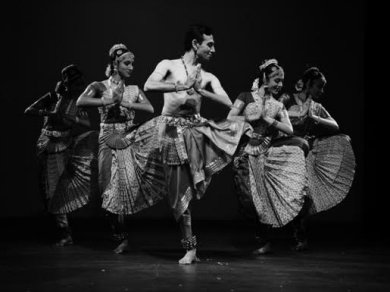
|   |

|   |
Nritya Vaibhava 2015 with Rasika Arts Foundation - Masoom Parmar e-mail: natyamasoom@gmail.com June 16, 2015 Weather and dance - two things I love about Bengaluru. And 29th May had both these things in the right proportions. So while the heavens opened up on Bengaluru, Seva Sadan was overflowing with rasikas for Rasika Arts Foundation’s 25th year celebrations. Started in 1990 by the dancing duo Sandhya - Kiran, the organization over the years has created some of the best dancing bodies and minds in the city. The event, aptly titled ‘Nritya Vaibhava’ featured Bengaluru’s favorite dancers Shruti - Parshwanath Upadhye (showcasing Kirans’ new works) and Praveen Kumar with his disciples (in his latest production ‘Mahamaya’). Shruti and Parshwanath began the recital with a Pushpanjali. For someone who is known for his vibrant stage presence, Parshwanath was a little low on energy in the beginning of the recital. Ably supported by his wife Shruti, a highly under-rated dancer, the choreography was neat and crisp. What was interesting was the use of space and geometry in the piece. The diagonal switching of positions and creative expression of the epithet “Mrityunjayaya” struck with the audiences leaving them asking for more. This was followed by Prabho Ganapati in Thillang raga and adi tala. The description of Lord Ganesha’s face and his interaction with his father Lord Mahadeva were endearing. What came next was a classic presentation Shankara sri giri composed by Maharaja Swathi Thirunal set to Hamsanandi raga and adi tala, a piece that showcased the brilliance of the guru and the shishya. The solo piece was a hallmark ‘Parshwanath Upadhye’ performance. Athletic jumps, karanas and the novel usage of Shiva’s damaru had the audience in raptures. Guru Kiran’s mastery over rhythm patterns was abundantly visible through the interaction between the orchestra ensemble and the dancer in different jathis. This masterpiece of performance was ably followed by Shruti Upadhye’s solo abhinaya piece Kandanaal Mudalaay composed by S. Chidambaram set to Madhuvanthi raga and adi tala. Abhinaya clearly is Shruti’s forte and she was at her best portraying the damsel in love with Lord Murugan. Her eyes spoke and how! The subtle, restrained expressions were a welcome, delightful change from the over exaggeration that a lot of dancers of my generation seem prone to. This reviewer sincerely hopes to see Shruti perform more often. The recital ended with a thillana composed by Guru Kiran and flautist Mahesh Swamy in raga Rasikapriya. The thillana felt like a poetic conversation that is strictly personal at a public forum. The dancing couple was ably supported by Balasubramanya Sharma (vocals), Chitra Vinod (nattuvangam), Mahesh Swamy (flute), Lingaraju (mridangam) and Shubha Santosh (veena)  Shruti and Parshwanath Upadhye  Praveen Kumar and Chithkala troupe The second half of the evening featured few parts from Mahamaya, a production based on the goddess by Praveen Kumar and his disciples. Praveen’s penchant for pushing the boundaries of the form while remaining true to its spirit notably stands out in this production. Portraying the goddess as a daughter, a young lady and then as a mother, Praveen takes calculated risks making intelligent usage of space. The nritta is crisp, the abhinaya effortless. The main piece, the famous daru varnam Maathey malaya dhwaja composed by Harikesanallur Muthaiah Bhagavatar set to Khamas raga, Praveen explored various stories of the Devi in his sancharis. Praveen brilliantly portrayed Mahishasura Mardhini to the lines Shaatodari Shankari Chamundeshwari. Even the fast paced jathis were gracefully managed. His students Navyashree, Hemalatha, Nidhi, Raksha, Divya and Shreema deserve special mention. To be able to almost match up to your guru’s caliber is not a small achievement. Praveen’s meticulous training is quite evident as the dancers hold their fort in the solos and the group work. All said, tighter script and some sort of uniformity in the aharya would make the production stronger. Praveen’s production was superbly supported by D.S. Srivathsa (vocals), Ramya Janakiraman (nattuvangam), Mahesh Swamy (flute) and Srihari Rangaswamy (mridangam). Two remarkable things in both the productions were the use of stage and intelligent lighting. It just helps the younger generation boost their confidence for experimenting with the form without jeopardizing the aesthetics or being OTT. While a lot of purists and traditionalists may disagree, these productions are a fitting example of making Bharatanatyam extant; traditional and yet modern. Masoom Parmar is an Arts Manager, a dancer and a physiotherapist based out of Bangalore. |